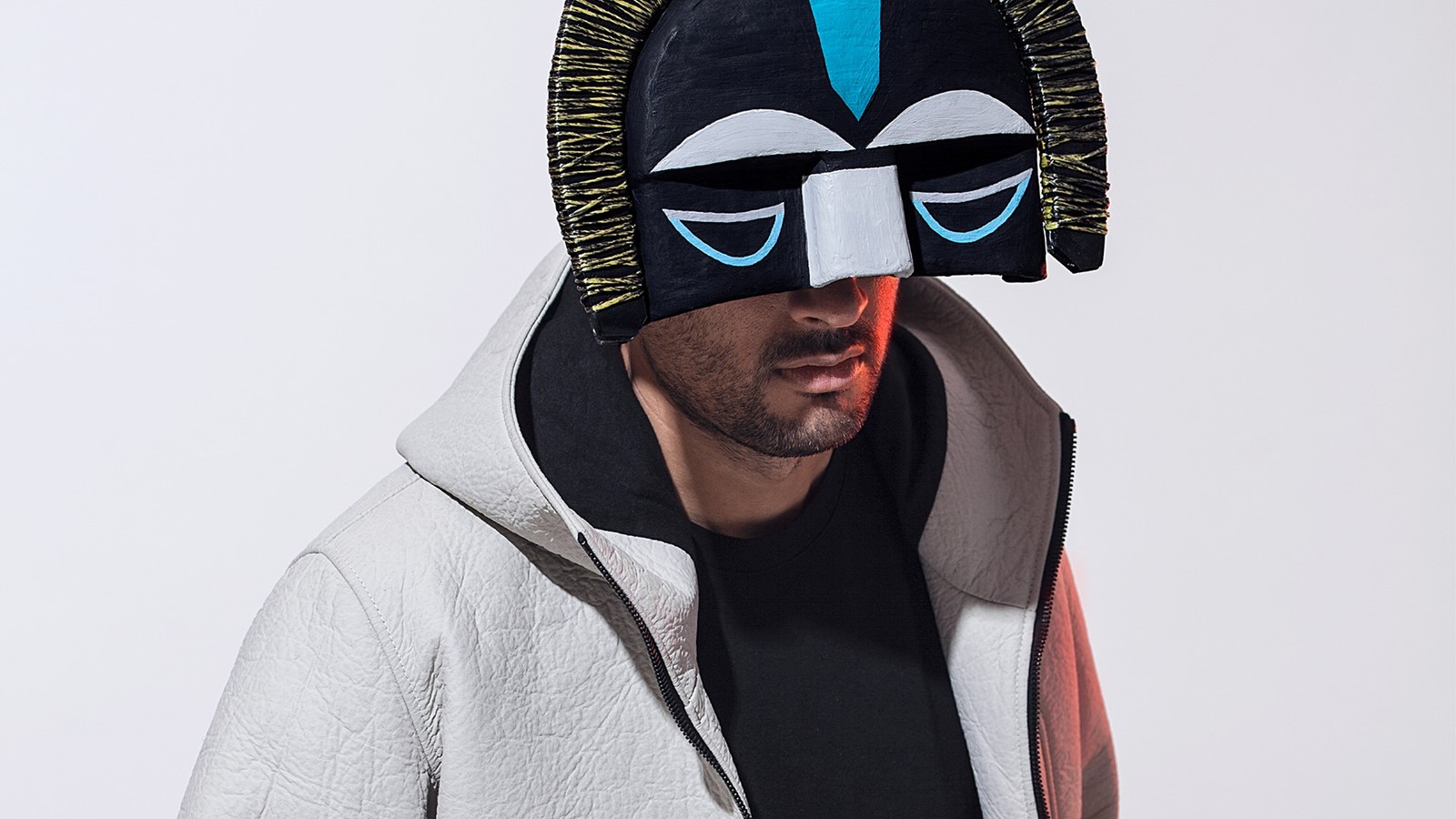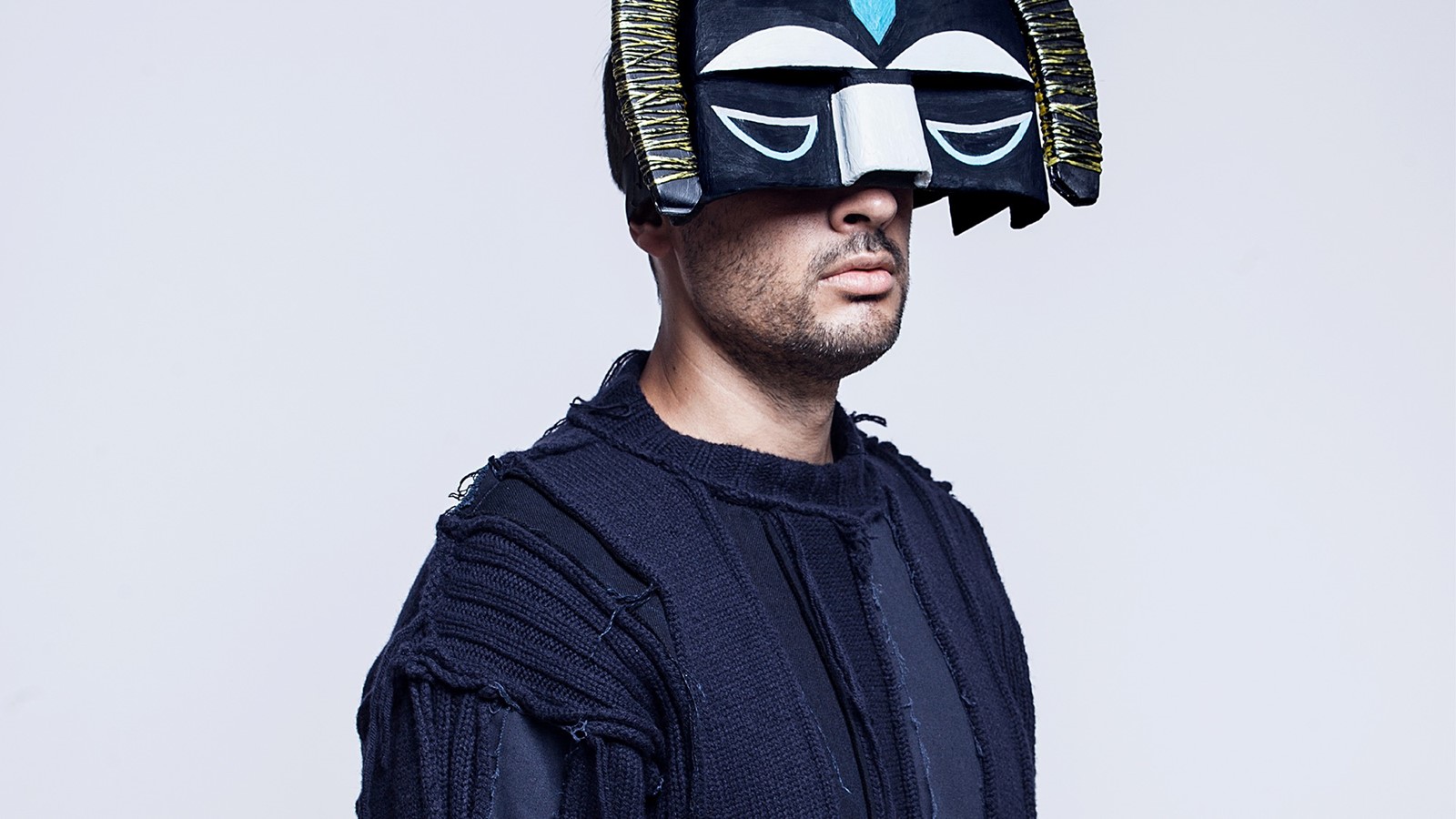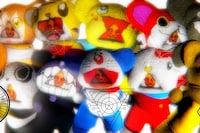Aaron Jerome on his obsession with fictional creatures, his revealing new album and why he went out to sea after the success of his debut
Aaron Jerome sits across a table from us in London’s Troxy theatre, his features obscure in the near-dark of the venue.
“I have this weird interest in cryptozoology,” he says. “Mythical animals like the Loch Ness monster and the yeti. Even in the early 1900s, you’d have botanists bringing back these weird animals on ships that people didn’t even know existed, things like komodo dragons or Tasmanian tigers.”
Jerome, the brains behind SBTRKT, is explaining the moderately barmy idea for the visuals underpinning his new album, Wonder Where We Land. Inspired by his unlikely fascination and the alebrijes of Mexican artist Pedro Linares – fantastical sculptures of dreamlike animals – Jerome created his own mythical beast to appear on the record’s sleeve, on the video for its lead single, and onstage in the form of an inflatable 20-foot replica.
“I just liked it as an analogy,” he says. “This idea of something that’s known to exist, but there’s nothing tangible that you really know about it. But I was also trying to bring new context to the SBTRKT identity. Initially, the idea behind the mask was to give freedom to the music. I don’t want people to fixate on the ‘return of the masked man’, and all those other mystery phrases that tend to get wheeled out. Cos that was never really the point.”
We’ve come to see Jerome at the East End venue as rehearsals get underway for SBTRKT’s upcoming UK tour. With the lights way down, it’s an almost comically apt setting for an audience with the Cambridgeshire-born producer, whose exotically masked alter-ego has helped keep his face out of the spotlight for about five years now.
“Initially, the idea behind the mask was to give freedom to the music. I don’t want people to fixate on the ‘return of the masked man’, and all those other mystery phrases that tend to get wheeled out. Cos that was never really the point” – Aaron Jerome
Jerome’s debut, SBTRKT, introduced a bright new talent to the post-dubstep melting-pot back in 2011, drawing on a host of vocal talents to push the often experimentally inclined scene towards a more broadly floor-friendly sound.
Then Drake hopped on a remix of its hookiest track, “Wildfire”; a watershed moment in US pop’s blossoming love affair with UK dance culture which sparked a rush of big-name acts beating a path to his door. Suddenly, everyone wanted a piece of the man behind the mask – but Jerome, it seems, had other ideas.
“I could’ve easily stepped out and done another “Wildfire” after the last record,” he says. “I probably had about 15, 20 requests from big major label artists all wanting a copycat track. But the thing is, even the ones I was into it was like, ’If you want what I do, I’ll come to the studio. We can start something unique between us, but I’m not gonna just give you the same beat.’”
If that makes him sound big-headed, rest assured there’s no Deadmau5-style giant ego lurking behind the mask with Jerome. In person, he’s relaxed and chatty in the extreme — if we’d sat him down alone with our Dictaphone for an hour, we’d still be confident of bagging a great interview — and it’s easy to imagine how his natural energy helps bring the best out of his collaborators.
“I mean, I’d love to be part of some of these bigger albums,” he says. “But while someone like HudMo is amazing at sending over full productions without anyone singing over it, my thing comes from that meeting of minds in the middle, rather than making a structure for someone to do something on top. I just don’t have that skillset, I’m somewhere in between the two.”

If Jerome was uncomfortable about surfing the zeitgeist all the way to the bank, plenty who’ve followed in his wake have enjoyed new levels of crossover success. Jessie Ware, whose 2010 track with Jerome “Nervous” helped land her a record deal, hit #5 in the charts with her debut Devotion in 2012, and AlunaGeorge just barely missed out on the Top 10 with Body Music in 2013. The same year also saw the rise and rise of Disclosure, who tore up the charts with their 90s house-tinged, weapons-grade retooling of SBTRKT’s sound.
All of which puts SBTRKT exactly one banger shy of serious mainstream attention in 2014, by our reckoning. But for Jerome, such considerations are a distant second to making the music you want to make.
“A lot of dance acts, even people like Disclosure who write big hits, have got a very distinct production sound, which makes me think a lot of it is pre-thought out and then they write big hooks on the top, in a team kinda way,” he says. “Whereas SBTRKT has never been about that, it’s more about creating something that’s unique each time with the collaboration.”
For his new album, Jerome wanted to push that collaborative approach into more ambitious, deeply personal territory. When Jerome was touring the first record, he adopted a two-piece set-up with regular collaborator Sampha that would allow room to improvise, thereby avoiding session-muso tedium or, even worse, the hollow charade of having “me press some buttons with a PA from the vocalist.”
The line-up has since expanded to include drummer Jimmy Holdom and Fabi Palladino on percussion and secondary synths, but the basic principle remains the same, and it’s precisely this kind playful, exploratory approach he wanted to bring to the new material.
Inspired by artists like Pink Floyd and D’Angelo — whose records are praised as having a distinct storyline and sense of the place they were created — Jerome set about scouting for a location that would help establish a mood for his album.
He wound up choosing Osea Island, an estuary plot in Essex connected to the mainland by a causeway which can only be crossed at low tide. At the turn of the 20th century, the island was home to a treatment centre for wealthy alcoholics, which was briefly revived as a rehab clinic in the 00s (Amy Winehouse was a patient there).
Having found somewhere suitably remote, Jerome out together a makeshift studio in a holiday home on the island, inviting a stream of collaborators — Sampha, Koreless, Andrew Ashong, Charlift's Caroline Polachek (who had to be rowed onshore by a local after arriving at high tide) — to help him flesh out his vision.
Working largely from first takes and with a minimum of overdubs, he felt his way around for a sound that would have “that stamp of ambiguity between live and electronic music”. Two songs, in particular, were key in setting the tone for what was to come: “Look Away”, a spooky, rather hazily defined track dominated by reverby piano chords and Caroline Polachek’s autotuned vocal, and “Wonder Where We Land”, which ended up supplying the record with its title thanks to an improvised lyric from Sampha.
“I guess it describes the vibe at Osea pretty well,” says Sampha of his lyric. “With those sessions, we didn’t really know what the outcome would be. We were just kind of foraging in the dark. But for me that song in particular is about the impermanence of everything — relationships, life — and this idea of entering into the unknown.”
Tragic circumstance also played its part in dictating Wonder Where We Land’s more introspected, sonically restless mood. About a month before work began on the record, Jerome’s older brother, Daniel, passed away after a five-year struggle with cancer.
“It was a weird time,” says Jerome. “Daniel was a big influence on me in terms of opening my eyes to not being boxed into listening to music. I’m originally from a farm in Cambridgeshire, and in that part of the world music isn’t normally the first thing people gravitate towards — but the thing is with my brother, he was into listening to everything, from rock to hip hop and dance, which made me realise you don’t only have to listen to one kind of thing.”
“A lot of my instrumental stuff before was primarily aimed at DJs playing it. And I wanna do more of that, showcase music in different formats. But it’s hard, because generally people don’t realise that artists do break the rules and do what the fuck they like” – Aaron Jerome
That yearning to transcend the limitations of genre can be heard on Transitions, a trilogy of instrumental EPs released for free online this year, which offered an early indicator of the more reflective direction in which SBTRKT’s music was heading.
“I think for me it was about saying my production had changed,“ says Jerome. “It was about creating these more immersive instrumentals which weren’t necessarily club-based records. Whereas a lot of my instrumental stuff before was primarily aimed at DJs playing it. And I wanna do more of that, showcase music in different formats. But it’s hard, because generally people don’t realise that artists do break the rules and do what the fuck they like.‘
The EPs were an instructive exercise for Jerome, who nonetheless knew he wanted to work closely with vocalists again for the second album. He says he had around “40 or 50“ names thrown at him in the run-up to its making, but took his time before settling on a cast which includes Vampire Weekend's Ezra Koenig, A$AP Ferg, Jessie Ware, Raury and Denai Moore (alongside Sampha, Polachek and the rest). It’s a considered approach that makes for a unique listening experience, and one that bucks the trend of producers cramming their records with guest vocalists in search of a crossover hit.
Take Ezra Koenig collab “New Dorp, New York“ as an example. A loopy, jazz-indebted number that sounds like nothing either artist has put his name to before, it could plausibly lay claim to being 2014’s weirdest pop song — and this, remember, is what Jerome selected as his first single. Elsewhere on the record, he coaxes similarly unexpected performances from A$AP Ferg and Atlanta newcomer Raury, who seem to relish the chance to spit bars in such outlandish settings. (The Ferg track, “Voices In My Head”, actually samples an abortive session Jerome recorded with Warpaint in LA.)
“I’m just very picky about who I work with,” says Jerome, who cites Erykah Badu was the one that got away for this album. “I like working with people who are proper artists rather than just being singers, because I could work with vocalists and then take all the credit for myself and say, ‘Well it’s all about SBTRKT, it’s not about the featuring person who sings all my top lines.’ And that’s a fundamental difference in why my albums won’t be successful in the same way that some artists’ records will, because they’re gonna have a whole team of people making sure the Ts are all crossed and the Is are dotted.”
Ultimately, he adds, it’s about forging a strong personal vision that leaves the box-ticking to other, more commercially-minded acts. By his own admission, Wonder Where We Land is only a “stepping stone” along that path, but it’s one he’s right to feel proud of: “If it sounds like a strong enough emotional message, I don’t need anyone to tell me where I need to be doing things differently.”
CREDITS
Photography: Nikola Lamburov
Styling: Kelly-Ann Hughes
Hair: Alex James Fairbairn
Make up: Cory Decking


